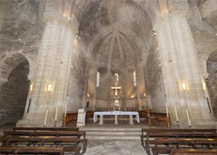
Locality: CARCASTILLO (31310)
Address: Carretera Ctra. Caparroso-Carcastillo km. 17,5
Zone: The Ribera
Style: Romanesque
Centuries of construction: XII
Tel.: 948725006
History
The solid stone walls of the Monastery of La Oliva have accumulated centuries of history in an oasis of peace and tranquillity.
La Oliva, one of the three monasteries that still remain in the Ribera (southern) area of Navarre, is now home to 26 Cistercian monks who can be seen, dressed in their white habits, walking through the cloister of the monastery in prayer.
The huge church, which is one of the truest examples of Cistercian art in Spain, the Gothic cloister, the capitular hall and the chapel of San Jesucristo reveal the great artistic importance of this monastery, built in the twelfth and thirteenth centuries, where it is easy to spend hours in peaceful meditation.
Your visit will allow you to discover the value of silence, but also the resonant sound of the liturgies chanted daily by the monks in vernacular tongue. Two kilometres from Carcastillo, on the banks of the river Aragon and in the middle of an esplanade with hardly any vegetation, stands the complex of medieval buildings that make up the Cistercian monastery of La Oliva.
Its name owes much to legend, as according to popular tradition a Navarrese king was mortally wounded while fighting the Arabs and went to die at the foot of a wild olive tree.
On the site of the wild olive tree, the monastery of La Oliva was founded in 1149 by the Cistercian order. After centuries of splendour in the Middle Ages, the War of Independence in the early 19th century and the confiscation of church property in 1835 left the monastery in ruins and abandoned until it was restored in the twentieth century and monastic life resumed.
Description
On arriving at the esplanade of the monastery, we find a monumental complex of magnificent simplicity. The entrance is through a deep pointed arch which is flanked by remains of a 12th-century wall and, on the upper part, the abbot’s palace. Once through the entrance you will discover a large complex made up of various buildings grouped around the cloister and open courtyards.
In the central part is the church of St. Mary (12th-13th centuries), which combines Gothic and Romanesque elements. It is regarded as one of the most perfect buildings of the Spanish-Languedoc school. Its interior reveals a breathtaking and gently lit space.
From the northern side of the church you access the medieval rooms of the monastery, laid out around the twelfth-century cloister that was rebuilt during the fourteenth and fifteenth centuries. Surrounding the cloister are the capitular hall, an excellent example of proto-Gothic art, the old sacristy, the refectory, the kitchen and a magnificent sixteenth-century staircase. Around these rooms are the remains of the storerooms and the chapel of San Jesucristo, standing in the fields as if it were a small hermitage.
In addition to its artistic riches, the monastery offers visitors the opportunity to attend, dressed decorously and in silence, the liturgies chanted daily by the monks in vernacular tongue, which take place at 4.30 am (Lauds), 7.00 am (Eucharist), 8.15 am (Terce), 12.45 pm (Sext), 3.10 pm (None), 6.30 pm (Vespers) and 8.45 pm (Compline and Salve).
Hospice
The monastery, which has a hostel where visitors can stay, has its own vineyards and cellars and markets its wines under the name of Monasterio de La Oliva. They include oak-aged Reservas and Crianzas, young reds, rosés, liqueur wine and wine for Mass. All of them, except the liqueur, are protected by the Designation of Origin ?Navarra’ and can be bought in the monastery shop.
Nearby areas
If you are interested in nature, visit the lake at Pitillas or the reservoir at El Ferial, a lake surrounded by pines. Both have a bird observatory. You could also choose to explore the Natural Park of the Bardenas Reales or head for Ujué (a few kilometres to the north of the monastery) to sample the traditional migas de pastor (literally, shepherd’s breadcrumbs).







